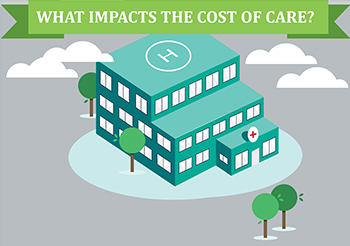Health Care Affordability
Health care affordability continues to be a challenge across the entire country. However, compared to the United States as a whole, Colorado is a frontrunner in making health care affordable. Coloradans spend less on health insurance premiums and deductible costs as a percentage of income than most states. Still, there is much that can and should be done to make health care more affordable.
Colorado hospitals have been a consistent and willing partner in advancing Colorado’s health care affordability efforts – from supporting legislative initiatives to continually focusing on efficient, effective, and coordinated delivery of care. Patient care delivery continues to evolve in the past, with even more care moving from traditional inpatient hospital settings to outpatient and other more cost-efficient and convenient settings. To manage that new patient expectation and demand, many hospitals and health systems have invested significantly in recent years in outpatient clinics and facilities, retail clinics, urgent care sites, and more. This ensures that the hospital can continue to meet the needs of its patients while also striving to provide care at the right place, at the right time and in the most cost-efficient way possible.
COVID-19 and Hospital Profits
The COVID-19 pandemic has put significant strain on hospital resources. Shortages in staffing and supplies and caring for sicker patients are all things that drive up operating expenses.
Prior to the pandemic, strong economic growth in Colorado allowed hospitals to invest in new technology and infrastructure. Colorado’s population continues to grow rapidly, and hospitals need to be able to invest in facilities to expand access to care and for new care delivery options in order to meet the growing demand.
That, coupled with decreases in other services (such as elective procedures), hospitals have experienced a decline in revenue and an increase in expenses. While federal provider relief funds have helped, continued increases in expenses and impact of COVID-19 surges have greatly exceeded all federal support.
Sustainability of Colorado Hospitals
Nearly half of Colorado hospitals are still at or below the national benchmark for long-term sustainability of an operating margin at 4 percent of revenues.
Hospitals must generate sustainable margins to provide funding for future community investments. Operating margins result from the excess of revenues after expenses for patient services. How much margin a hospital may need for future investments depends on many factors including taxable status, age of current facilities and equipment, expected population growth, health care needs of the community, and availability of other community or federal financial support. Sustainable operating margins for hospitals typically range from 2-6 percent of patient revenues.
Some Colorado hospitals have strong investment portfolios and benefit from strong national economy, especially those along the Front Range. Hospitals and health systems that have strong investments – including financial and real estate holdings – have benefitted from that economic performance.
What impacts the cost of care?
Consumers seek value from the health care they receive. Being aware of the many factors most traditionally cited as contributors to price variation may help you better understand which of them might affect the cost of care at a given hospital. Click here or on the image to the right for a visual representation on the variety of factors that influence price variation at health care facilities.
Understanding Personal Health Care Costs
Health care is a vast and complex industry that can be daunting for patients and their families to navigate. Colorado Hospital Association and its members are dedicated to ensuring that patients are able to get the right care at the right time while also having the right information.
Typically, the most accurate way to find information about their health care costs is to contact their health insurance provider, which will have answers pertaining to hospitals, providers and services covered under their plan. Health insurance companies will also have patient-specific information regarding costs they will be responsible for, such as deductibles and out-of-pocket maximums. In addition, recent legislation requires hospitals and insurance carriers to provide health care cost information on-line that is accessible to understandable for patients.
If a patient does not have health insurance, the best way to get accurate pricing information is by calling their hospital or provider directly and requesting a price estimate. Most hospitals in Colorado offer discounted rates and charity care for patients that qualify and are not covered by insurance, in addition to payment plans for any out-of-pocket costs.
Also, in a joint project between the Colorado Hospital Association and the Colorado Department of Regulatory Agencies, Division of Insurance, consumers and purchasers of health care services can find more information about average hospital charges and average reimbursement rates paid by insurance companies or health maintenance organizations. The report includes the 25 most common inpatient medical conditions and surgical procedures performed by hospitals.
Other Resources
The Healthcare Financial Management Association (HFMA) released a comprehensive consumer guide for understanding health care costs and pricing.
The Colorado Hospital Price Report gives health care consumers more information about average hospital charges and average reimbursement rates paid by insurance companies or health maintenance organizations.
The DORA Price Report contains information on the average hospital charges for specific diagnosed procedures compared to the average reimbursement that insurance companies will pay for patients.
This database is the state’s most comprehensive source of health care insurance claims information representing the majority of covered individuals in the state.
